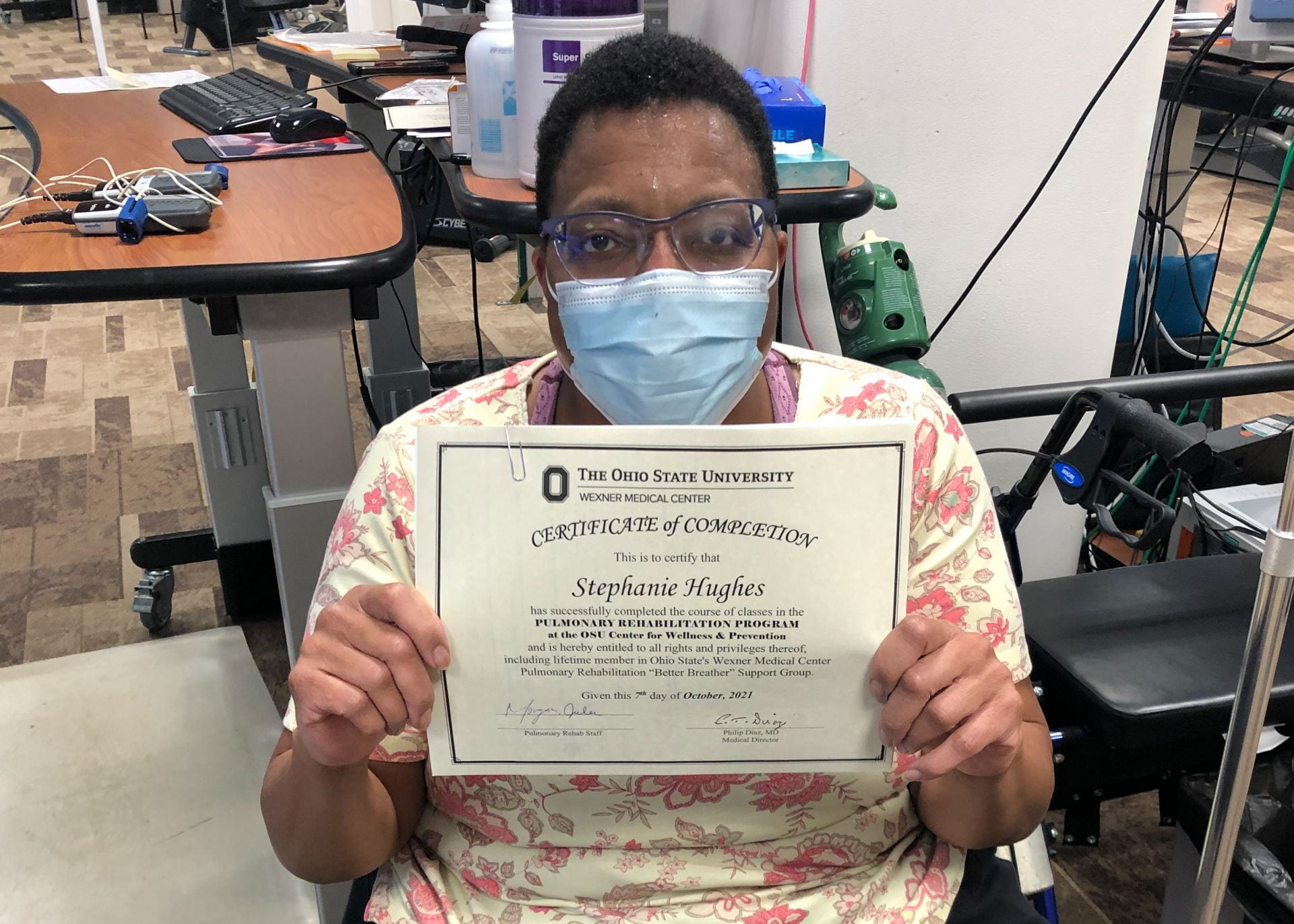
Stephanie Hughes received pulmonary rehab and post-COVID-19 recovery treatment at Martha Morehouse Pavilion. Credit: Courtesy of Stephanie Hughes
The path to recovery from a COVID-19 diagnosis varies for all patients.
A program directed by the Wexner Medical Center at Ohio State now aims to treat “long COVID-19” — when virus symptoms or other new health issues persist after the contagion period has passed. Dr. Julie Mangino, professor emeritus in the Department of Internal Medicine, said about one-third of people with COVID-19 struggle with the virus for a long time.
Mangino said the number of people who experience long COVID-19 varies study by study. She said the most common symptoms people experience are brain fog, fatigue and shortness of breath.
For long COVID-19 patients, the 14-day quarantine period after a positive test is the start of a new reality, Stephanie Mitchell Hughes, a local attorney who tested positive in December 2020, said.
Hughes said after quarantining and receiving a negative test, she attempted to return to her routine, which included yoga classes three times a week.
After a few weeks of normalcy, she crashed at the end of a class in mid-February.
“I couldn’t get up off the ground,” Hughes said. “It was like, I can’t get up when I was ready to get up and walk out of the room. And it was like my body was sort of crashing and shutting down, and it’s just been kind of downhill.”
Having raised her now-adult children by herself, Hughes said she is no stranger to pushing her limits. However, COVID-19’s effect on her physical and mental state proved difficult to overcome.
“My experience has always been: I muddle through, regardless of what it is,” Hughes said. “You cannot muddle through long COVID.”
To address her symptoms, Hughes said she turned to the medical center’s post-COVID-19 recovery program, co-directed by Dr. Jodi Grandominico and Dr. Lynn Fussner. Working with 15 clinics and specialists in Columbus, the program addresses the needs of local long COVID-19 patients.
Grandominico, associate director of clinical operations for the division of General Internal Medicine at Ohio State and an associate professor at the College of Medicine, said the idea for the clinic originated in March, at the end of a virus surge.
“We started thinking about taking care of some of these post-COVID patients,” Grandominico said. “Since the start of the clinic, we’ve seen about 300 patients.”
Hughes said at her recovery appointments in the Martha Morehouse Pavilion, participants would use traditional exercise machines, such as ellipticals and treadmills. However, long COVID-19 patients must also work to regain control over everyday motions and movements.
“Probably the most difficult exercise that we do is standing up and sitting down: stand up, sit down 15 times, and we have to — oddly enough, regardless of where you are — we always had to take a little bit of a break,” Hughes said.
After attending the recovery program for 24 weeks, Hughes said she felt the twice-weekly meetings had improved her health, and she registered for pulmonary maintenance — a continuation of the recovery program’s rehabilitative efforts.
“I have to pay for that out of my own pocket,” Hughes said. “I signed up for pulmonary maintenance, just to try not to lose any ground that I left, and also continue to improve my capacity.”
Michael Altomare, who contracted COVID-19 in April 2020, said he still suffers from symptoms over a year after his hospital discharge.
“I still have the fatigue, the anxiety, the depression; cognitively, I’m still not back, which is hard for me,” Altomare said. “They told me that a year post-ICU, you’ll kind of have an idea of where you are. Well, I hope that’s not it. I still hope there’s room.”
Prior to the effort’s launch in May, Altomare and his wife were navigating emerging COVID-19 research with the help of their family doctor, but lacked specialist input or specific post-hospitalization protocols.
“We got very little information as far as discharge instructions because no one really knew what COVID was going to do long-term,” Altomare said. “We were fortunate to get a hold of my family doctor, who’s been following my case; he did a wonderful job managing what we knew at the time until I could get into Ohio State’s process.”
Since joining the program, Altomare said he has found himself surrounded by informed clinicians whose research into both the virus’s effects and their patients’ medical needs has been impressive.
Mangino said she recommends students continue to follow health guidelines and stay aware of the virus’s prevalence in the community.
“Wear a mask everywhere you go, when you’re indoors. Make sure that it’s not damp, loose, or soiled. Trying to social distance is still a good thing,” Mangino said. “We are not out of this yet, so get vaccinated and wear masks whenever you’re indoors.”


